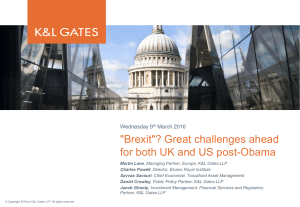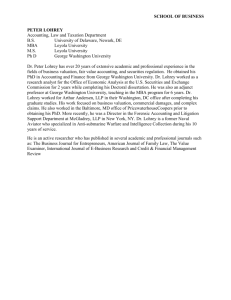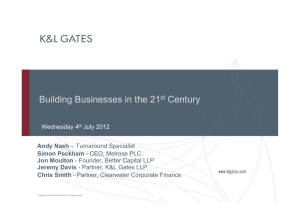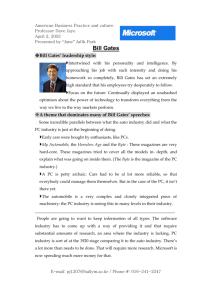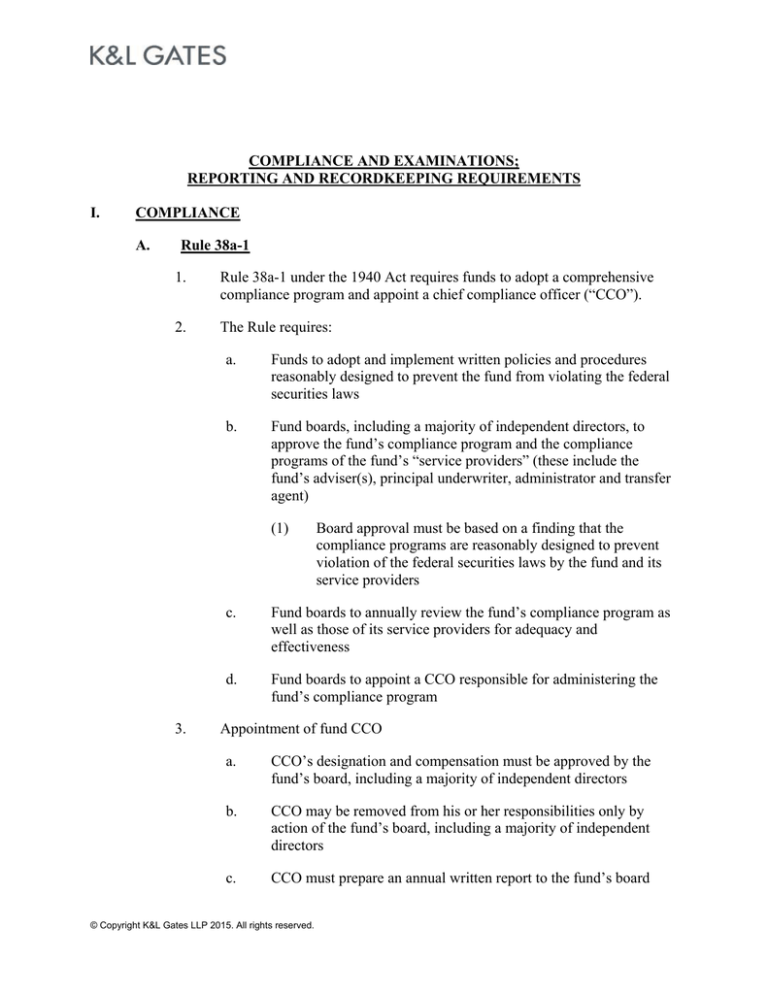
COMPLIANCE AND EXAMINATIONS;
REPORTING AND RECORDKEEPING REQUIREMENTS
I.
COMPLIANCE
A.
Rule 38a-1
1.
Rule 38a-1 under the 1940 Act requires funds to adopt a comprehensive
compliance program and appoint a chief compliance officer (“CCO”).
2.
The Rule requires:
a.
Funds to adopt and implement written policies and procedures
reasonably designed to prevent the fund from violating the federal
securities laws
b.
Fund boards, including a majority of independent directors, to
approve the fund’s compliance program and the compliance
programs of the fund’s “service providers” (these include the
fund’s adviser(s), principal underwriter, administrator and transfer
agent)
(1)
3.
Board approval must be based on a finding that the
compliance programs are reasonably designed to prevent
violation of the federal securities laws by the fund and its
service providers
c.
Fund boards to annually review the fund’s compliance program as
well as those of its service providers for adequacy and
effectiveness
d.
Fund boards to appoint a CCO responsible for administering the
fund’s compliance program
Appointment of fund CCO
a.
CCO’s designation and compensation must be approved by the
fund’s board, including a majority of independent directors
b.
CCO may be removed from his or her responsibilities only by
action of the fund’s board, including a majority of independent
directors
c.
CCO must prepare an annual written report to the fund’s board
© Copyright K&L Gates LLP 2015. All rights reserved.
K&L Gates LLP
d.
B.
CCO must meet separately with the fund’s independent directors at
least annually
Creating a Compliance Program
1.
2.
3.
Conduct a Risk Assessment
a.
Identify “high risk” areas or practices
b.
Use risk assessment to develop compliance policies and procedures
c.
Regularly review risk assessment to incorporate new activities or
products
Develop Policies and Procedures
a.
Coordinate policies and procedures with the fund’s unique
compliance risks, addressing and managing each risk
b.
Review, test, and assess each policy and procedure
Appoint Chief Compliance Officer
a.
4.
5.
6.
Choice of either “inside” or “outside” CCO. Either can be
legitimate, but must address issues associated with choice
Disclosures
a.
Ensure disclosures are consistent with actual practices
b.
Review regularly to ensure disclosures remain current
Recordkeeping
a.
Create, record, retain all required information, including
information in electronic format
b.
Be able to access needed information quickly
c.
Safeguard information from unauthorized access
Conduct Annual Review
-2-
© Copyright K&L Gates LLP 2015. All rights reserved.
K&L Gates LLP
C.
Written Policies and Procedures
1.
Rule 38a-1 does not specify the areas to be covered by the compliance
programs of the fund or its service providers.
2.
Compliance policies and procedures for a particular fund need only
encompass areas relevant to that fund.
3.
The SEC set forth in the adopting release for Rule 38a-1 the following
suggested areas in which the compliance programs of a fund and its adviser
should address, to the extent they are relevant:
a.
b.
Portfolio management
(1)
Style drift - chasing returns
(2)
Violation of investment restrictions
(3)
Window dressing and portfolio pumping
(4)
Unfair allocation of securities, including initial public
offerings
(5)
Use of 17a-7 and 10f-3 transactions to “dump” unfavorable
securities
(6)
Cherry picking
Trading activities and practices
(1)
Failure to obtain best execution
(2)
Failure to periodically and systematically review execution
quality and to route and re-route orders accordingly
(3)
Use of commissions to obtain goods/services outside the
Section 28(e) safe harbor, and without adequate disclosure
to clients/shareholders
(4)
Interpositioning of an affiliated broker-dealer
-3© Copyright K&L Gates LLP 2015. All rights reserved.
K&L Gates LLP
c.
d.
e.
(5)
Use of commissions outside of a 12b-1 plan to pay for
distribution; or use of commissions to pay for client
referrals without disclosure
(6)
Failure to clearly disclose to clients the use of their
commission dollars
Proprietary trading of the adviser and personal trading by
employees
(1)
Market timing, insider trading, front-running or other
abusive personal or proprietary trading
(2)
Untimely or failure to report personal securities
transactions
(3)
Codes of ethics violations
(4)
Failure to properly identify and monitor trading by all
access persons
The accuracy of disclosures made to investors, clients and
regulators, including account statements and advertisements
(1)
Inaccurate or misleading performance numbers
(2)
Inadequate supporting documentation for performance
claims
(3)
Misleading advertisements
(4)
Inadequate disclosure of revenue sharing arrangements
(5)
Misleading statements in Form ADV, Part II, prospectuses
or other documents
Safeguarding of client assets from conversion or misuse
(1)
Improper or inadvertent access to client assets
(2)
Unauthorized trading in client accounts
(3)
Improper disclosure of client account information
-4-
© Copyright K&L Gates LLP 2015. All rights reserved.
K&L Gates LLP
(4)
f.
g.
h.
i.
Discrepancies between the records of the adviser and the
custodian
Creating and maintaining accurate books and records
(1)
Failure to maintain and have accessible all required books
and records, including emails
(2)
Failure to protect records and information from
unauthorized access and manipulation
(3)
Maintaining inaccurate books and records— e.g., failure to
accurately or timely post revenue or expense numbers
(4)
Failure to produce business records required by OCIE
Marketing advisory services, including the use of solicitors
(1)
Failure to disclose or inadequate disclosure of solicitation
arrangements
(2)
Failure of solicitor to deliver the adviser’s Form ADV, Part
2A
(3)
Failure to disclose payments to employees for referrals
(4)
Failure to have written contracts with solicitors
Valuing client holdings and assessing fees
(1)
Illiquid or fair valued assets not valued appropriately, or
values not back tested
(2)
Inaccurate computation of fees, or fees based on inaccurate
valuation of client assets
Creating and protecting the privacy of client records and
information
(1)
Lack of verification that client data is compiled accurately
(2)
Integrity of client data is not protected from unauthorized
changes
-5-
© Copyright K&L Gates LLP 2015. All rights reserved.
K&L Gates LLP
j.
D.
(3)
Failure to safeguard the privacy of client information
(4)
Failure to notify clients of policies on safeguarding their
information
Business continuity plans
(1)
Failure to prepare for and test operations during human or
natural emergencies
(2)
Failure to provide for availability of critical personnel and
systems
(3)
Failure to verify continuity plans of third party providers
(4)
Failure to protect records from unplanned destruction
Chief Compliance Officer
1.
2.
Each fund must designate a CCO to administer its compliance program.
a.
The CCO should be competent and knowledgeable regarding the
Investment Company Act and other applicable federal securities
laws
b.
The CCO should be empowered with full responsibility and
authority to develop and enforce an appropriate compliance
program for the fund
c.
The CCO must have a position of seniority and authority sufficient
to compel others to adhere to the compliance program
CCO’s annual written report is required to include information about:
a.
Operation of the policies and procedures of the fund and its
principal service providers
b.
Material changes made to those policies and procedures since the
date of the last report
c.
Material changes to the policies and procedures recommended as a
result of the annual review
-6-
© Copyright K&L Gates LLP 2015. All rights reserved.
K&L Gates LLP
d.
3.
4.
“Material Compliance Matters” that occurred since the date of the
last report
CCO’s annual written report also may include information about
a.
Management cooperation
b.
Risk assessment methods, analysis and conclusions
c.
Industry best practices
d.
Back testing results
e.
Violations
f.
Remedial actions
g.
Prior concerns
h.
Compliance certifications
i.
Compliance personnel assessment
j.
Self evaluation
k.
Compliance budget, resources, staffing
l.
Training and education
m.
Changes/updates to program
n.
Overall assessment
o.
Goals for the coming year
CCO’s annual meeting with independent directors
a.
Include counsel to the independent directors but not management
and adviser personnel or interested directors
b.
Discuss sensitive compliance concerns
-7© Copyright K&L Gates LLP 2015. All rights reserved.
K&L Gates LLP
E. Annual Reviews
1.
Rule 38a-1 requires fund boards to review the fund’s compliance program
and the compliance programs of its service providers annually for adequacy
and effectiveness.
2.
The Rule does not provide specific guidance as to how to conduct an
annual review. However, SEC staff has discussed specific issues that have
been raised, while also noting that each fund’s review process should be
tailored to its unique circumstances.
3.
While funds have flexibility to determine the specific structure and content
of an annual review, the goal across funds is the same: to discover if the
compliance program is working properly to prevent, detect, mitigate, and
correct compliance issues.
4.
Some issues the SEC staff identified in its inspections:
a.
b.
Risk identification
(1)
Failing to assess unique risk exposures that do not appear
on generic checklists
(2)
Failing to coordinate the risks identified with compliance
policies and procedures
Policies and procedures
(1)
Overlooking the need for separate written policies for one
of multiple registered entities within a complex
(2)
Lacking written policies in a particular area such as:
(3)
(i)
market timing
(ii)
conflicts of interest when voting proxies
(iii)
supervision of sub-advisers
(iv)
insider trading
Failing to enforce policies and procedures
-8-
© Copyright K&L Gates LLP 2015. All rights reserved.
K&L Gates LLP
c.
d.
e.
f.
5.
Written report to the fund board
(1)
Overwhelming a board with too much information
(2)
Not giving a board enough information
Testing
(1)
Failing to perform any tests when tests could have been
useful
(2)
Failing to perform appropriate tests that could have
resolved specific problems
The CCO
(1)
Addressing conflict of interest issues of an “inside” CCO
(2)
Providing a CCO with the authority and influence needed
to do the job
(3)
Ensuring an “outside” CCO is involved, experienced, and
has enough access to do the job
Implementing Recommendations
(1)
Ensuring that findings from the annual review are analyzed
and applied
(2)
Obtaining support from executives and management
Other lessons learned and advice in preparation for the next annual
compliance program review
a.
Do not put off preparing for the next annual review.
(1)
Develop a compliance calendar. Use the information from
the last annual review to help anticipate which areas had
the most issues and what took the longest.
(2)
Provide ongoing training to compliance staff.
-9© Copyright K&L Gates LLP 2015. All rights reserved.
K&L Gates LLP
(3)
b.
F.
Schedule tests year-round, follow up on tests to ensure they
have been completed, and allow time to analyze the results.
Keep compliance policies dynamic.
(1)
Identify changes in practices, affiliates, products, or
services. Re-examine risk assessment and keep it updated
as potential risks evolve
(2)
Keep updated on regulatory changes and update policies
accordingly
c.
Form compliance contacts to discuss industry practices. Keep in
mind that industry practice does not necessarily equal best practice.
d.
Follow through on issues raised during the last annual review.
Required Records
1.
Funds must maintain copies of all compliance programs in effect at any
time during the last five years (with the most recent two years in an easily
accessible place), including
a.
Materials provided to the board in connection with its approval of
the fund’s and service providers’ compliance programs
b.
Any annual written reports by the fund’s CCO
2.
Funds are required to keep any records documenting their annual reviews
for at least five years after the end of the fiscal year in which the annual
review was conducted (with the most recent two years in an easily
accessible place).
3.
Records may be maintained electronically, and must be provided in
electronic format to the SEC upon request.
a.
No attorney-client privilege, work-product doctrine, or similar
protections.
- 10 © Copyright K&L Gates LLP 2015. All rights reserved.
K&L Gates LLP
II.
EXAMINATIONS
A.
Preparation and Management of the Regulatory Exam Process
1.
Regulatory environment has changed dramatically
2.
SEC Response: Changes to OCIE exam program including:
3.
a.
Expertise of exam teams
b.
Enhanced scrutiny for compliance with the federal securities laws
c.
Enhanced scrutiny for the detection of fraud
d.
More aggressive enforcement actions
More important than ever that advisers are well prepared to handle
examinations
a.
Most enforcement actions originate from examinations
b.
Enforcement actions can have very serious consequences
c.
Most frequent and intensive face-to-face interactions with SEC
staff
d.
Clients, insurers and business partners asking to review deficiency
letters
4.
OCIE has a centralized unit for risk assessment
5.
Regulatory Exam Preparation
a.
Designate a contact person - CCO
b.
Review prior examination records
c.
Arrange for examiner work area and resources
d.
Notify senior management and personnel of the exam
e.
Organize files prior to arrival of examiners
- 11 -
© Copyright K&L Gates LLP 2015. All rights reserved.
K&L Gates LLP
6.
7.
8.
f.
Walk through the office
g.
Prepare opening presentation
Regulatory Exam Management
a.
Present a professional appearance
b.
Do not keep the examiners waiting
c.
Ask the examiners for their business cards
d.
Documents should be ready
e.
Confirm the schedule of meetings with specific individuals and let
the examiners know CCO will be present for all interviews
f.
Examiners should not make copies themselves – retain duplicates
g.
Address deficiencies identified during the course of the exam
h.
Request an exit interview
The Relationship Between the Annual Review and Examinations
a.
SEC examiners are looking for effective control and compliance
systems
b.
Demonstrate documentary evidence showing:
(1)
Risks are identified, managed and mitigated
(2)
Problems are found as they occur
(3)
Problems are resolved promptly
Addressing Exam Deficiencies and Identifying Hot Topics
a.
Possible exam results
(1)
No findings or violations
(2)
Deficiency letter
- 12 -
© Copyright K&L Gates LLP 2015. All rights reserved.
K&L Gates LLP
(3)
b.
Deficiency letter arrives
(1)
Immediate attention requires written response
(2)
Possible corrective action:
(3)
III.
Enforcement referral
(i)
revising compliance policies or procedures
(ii)
implementing new exception or surveillance reports
(iii)
changing the level or frequency of reviews
Request confidentiality
PERIODIC REPORTING
A.
Reports to the SEC
1.
Section 30(a) of the 1940 Act provides that every registered investment
company shall annually file with the SEC such information, documents,
and reports as investment companies that have securities registered on a
national securities exchange must file annually under Section 13(a) of the
Exchange Act. However, pursuant to Rule 30d-1, a registered investment
company that is required to file annual and quarterly reports pursuant to
Section 13(a) of the Exchange Act shall satisfy its requirements by filing
reports on Form N-CSR and Form N-Q.
2.
Rule 30b1-1 requires a registered management company to file a semiannual report on Form N-SAR within 60 days after the close of each fiscal
semi-annual period.
3.
Rule 30b1-4 requires a registered management investment company to file
an annual report on Form N-PX not later than August 31 of each year,
containing the fund’s proxy voting record for the most recent 12-month
period ended June 30.
4.
Rule 30b1-5 requires a registered management investment company to file
quarterly reports on Form N-Q not more than 60 days after the close of the
first and third fiscal quarters.
- 13 © Copyright K&L Gates LLP 2015. All rights reserved.
K&L Gates LLP
5.
Rule 30b1-7 requires a money market fund to file a monthly report on
Form N-MFP not later than the fifth business day of each month.
6.
Rule 30b2-1(a) requires a registered management investment company to
file a report on Form N-CSR not later than 10 days after the transmission to
shareholders of any report required pursuant to Rule 30e-1(a).
7.
Rule 30b2-1(b) requires a registered management investment company to
file a copy of any periodic or interim report or similar communication
containing financial statements that is transmitted to shareholders but is not
required to be filed under Rule 30b2-1(a) not later than 10 days after the
transmission to shareholders.
- 14 © Copyright K&L Gates LLP 2015. All rights reserved.
K&L Gates LLP
B.
Reports to Shareholders
1.
Rule 30e-1(a) requires that an investment company transmit reports to
shareholders at least semi-annually
2.
The reports must include the following
a.
The following information and financial statements, which, in the
case of the annual report, must be audited
(1)
Statement of net assets (or assets and liabilities)
(2)
Schedule of Investments
(3)
Statement of operations
(4)
Statement of changes in net assets
(5)
Statement of aggregate dollars amounts of purchase and
sales of investment securities
(6)
Financial highlights
b.
Statement of aggregate remuneration paid to directors, officers and
others
c.
The report of the accountants (annual reports only). Section 30(g)
requires the audit report to state that the independent public
accountants have verified securities owned either by actual
examination or by confirmation from the custodian
d.
Information concerning changes in and disagreements with
accountants
e.
Biographical information for each director and officer required by
Item 12(a)(1) of Form N-1A (annual reports only)
f.
Statement of availability of additional information about fund
directors (annual reports only)
g.
If any matter was submitted to a shareholder vote during the period
covered by the report, or if shareholder consents were solicited, the
date and type of meeting and a summary of the matter(s) and the
- 15 -
© Copyright K&L Gates LLP 2015. All rights reserved.
K&L Gates LLP
results of the vote. For an election of directors, the report should
contain the names of the directors who were elected and the names
of any directors whose term is continuing
h.
Management’s discussion of fund performance (annual reports
only). Money market funds are exempt from this requirement. The
presentation must include
(1)
A discussion of the factors that materially affected fund
performance during the most recently completed fiscal
year, including the relevant market conditions and the
investment strategies and techniques used by the fund’s
adviser. Particular attention must be paid to text
accompanying the financial statements, because it may be
viewed as advertising or sales literature
(2)
A line graph showing the growth of $10,000 invested over
the last 10 fiscal years (or period since the fund was first
registered, if shorter), and the growth of $10,000 invested
in “an appropriate broad-based securities market index” for
the same period
(3)
A table showing the fund’s average annual return for the
one-, five-, and 10-year periods ending at the end of the
most recently completed fiscal year, and a statement that
past performance does not predict future performance and
that the graph and table do not reflect the deduction of
taxes that a shareholder would pay on fund distributions or
the redemption of fund shares. Rule 34b-1, which governs
the timeliness of performance information in sales
literature, provides an exemption for annual and semiannual reports to shareholders
i.
An expense example
j.
Graphical representation of holdings
k.
Statement regarding availability of quarterly portfolio schedule
l.
Statement regarding availability of proxy voting policies and
procedures
- 16 -
© Copyright K&L Gates LLP 2015. All rights reserved.
K&L Gates LLP
C.
m.
Statement regarding availability of proxy voting record
n.
Statement regarding basis for approval of investment advisory
contract
3.
The report must be transmitted to shareholders within 60 days of the end of
the fiscal period to which it relates. Reports must be filed with the SEC on
Form N-CSR no later than 10 days after they are first sent or given to
shareholders.
4.
Rule 30e-1(d) permits an open-end investment company to send a copy of
its currently effective prospectus or statement of additional information, or
both, to shareholders in satisfaction of the annual or semi-annual report
requirement if it includes all the information that would otherwise be
required to be contained in the report. A prospectus or statement of
additional information, or both, mailed instead of an annual or semi-annual
report must be mailed within 60 days after the close of the relevant period.
Thus, in order to make this a usable option, the fund must carefully observe
the 60-80 day effectiveness provision of Rule 485(a) for post-effective
amendments to ensure that all reviews and submissions will be made in a
timely manner so that the new prospectus will become effective within the
60-day period for mailing the annual report.
Proxy Voting Requirements Applicable to Registered Investment Companies
1.
Registered management investment companies are required to disclose in
their registration statements (and, in the case of closed-end funds, Form NCSR) the policies and procedures that they use to determine how to vote
proxies relating to portfolio securities. See Instruction 12(f) to Form N-1A.
2.
Registered management investment companies are required to file with the
SEC and to make available to their shareholders, either on their websites or
upon request, their records of how they voted proxies relating to portfolio
securities. Funds are required to disclose in their annual and semi-annual
reports to shareholders and in their registration statements the methods by
which shareholders may obtain information about proxy voting.
3.
The following are examples of general policies and procedures that some
funds include in their proxy voting policies and procedures and with
respect to which the SEC has indicated that disclosure would be
appropriate:
- 17 -
© Copyright K&L Gates LLP 2015. All rights reserved.
K&L Gates LLP
4.
IV.
a.
The extent to which the fund delegates its proxy voting decisions
to its investment adviser or another third party, or relies on the
recommendations of a third party
b.
Policies and procedures relating to matters that may affect
substantially the rights or privileges of the holders of securities to
be voted
c.
Policies regarding the extent to which the fund will support or give
weight to the views of management of a portfolio company
Form N-PX requires disclosure of the following information for each
matter relating to a portfolio security considered at any shareholder
meeting held during the period covered by the report and with respect to
which the fund was entitled to vote:
a.
The name of the issuer of the portfolio security
b.
The exchange ticker symbol of the portfolio security
c.
The Council on Uniform Securities Identification Procedures
("CUSIP") number for the portfolio security
d.
The shareholder meeting date
e.
A brief identification of the matter voted on
f.
Whether the matter was proposed by the issuer or by a security
holder
g.
Whether the fund cast its vote on the matter
h.
How the fund cast its vote (e.g., for or against proposal, or abstain;
for or withhold regarding election of directors)
i.
Whether the fund cast its vote for or against management
RECORDKEEPING REQUIREMENTS
A.
Books and Records of the Investment Company
1.
Section 31 of the 1940 Act sets out the requirements pertaining to the
books and records of registered investment companies. It requires the
- 18 -
© Copyright K&L Gates LLP 2015. All rights reserved.
K&L Gates LLP
company, and its underwriters, brokers, dealers or investment advisers to
maintain and preserve the books and other documents that constitute the
basis of the financial statements. In addition, investment advisers that are
not majority-owned subsidiaries, depositors and principal underwriters
must maintain records of their transactions with the fund. These books and
records are subject to examination by the SEC.
2.
3.
Rule 31a-1 requires an investment company to maintain and keep current:
a.
original entry journals containing an itemized detailed daily record
of all securities purchases and sales (including its own securities),
all receipts and deliveries of securities, and all receipts and
disbursements of cash and all other debit and credits
b.
general and auxiliary ledgers reflecting all asset, liability, reserve,
capital, income and expense accounts, including separate ledger
accounts for specific activities as set forth in the rule
c.
corporate charters, certificates of incorporation or trust agreements,
by-laws and minute books of meetings
d.
specific records of each transaction and investment as set forth in
the rule
e.
a record identifying their persons or persons, committees or groups
authorizing the purchase or sale of portfolio securities
f.
files of all advisory material received from the investment adviser
or any persons from whom the fund accepts investment advice
g.
other records, as appropriate
Rule 31a-2 requires an investment company to retain records for the
following time periods:
a.
Journals, ledgers and corporate documents must be preserved
permanently, the first two years in an easily accessible place
b.
The other records described above must be preserved for six years,
the first two years in an easily accessible place
- 19 © Copyright K&L Gates LLP 2015. All rights reserved.
K&L Gates LLP
c.
B.
The following records must also be preserved for six years, the
first two years in an easily accessible place:
(1)
Any advertisements, pamphlets, circulars, form letters or
other sales literature addressed to or intended for
distribution to prospective investors
(2)
Any record of the initial determination that a director is not
an interested person and each subsequent determination
(including any questionnaire used to make such
determination)
(3)
Any materials used by the disinterested directors to
determine that a person who is acting as their legal counsel
is an independent legal counsel
(4)
Any documents or other written information considered by
the directors pursuant to Section 15(c) of the 1940 Act in
approving the terms or renewal of a contract or agreement
between the company and an investment adviser
4.
Rule 38a-1 contains additional recordkeeping requirements with respect to
fund compliance programs. See Section I.E. of this Chapter for a
discussion of these requirements.
5.
Rule 2a-7, which governs money market funds, contains additional
recordkeeping requirements that apply to those funds. See Chapter 12 for a
discussion of these requirements.
Books and Records of Investment Advisers and Principal Underwriters
1.
Investment advisers and principal underwriters are required to maintain and
preserve the accounts, books and other documents that reflect their
transactions with the fund.
2.
Investment advisers are required by Rule 204-2 under the Advisers Act to
make and keep current records of:
a.
Journals, ledgers, memoranda and other records detailing each
transaction with the fund
- 20 © Copyright K&L Gates LLP 2015. All rights reserved.
K&L Gates LLP
b.
originals of all written communications received and copies of all
written communications sent by such investment adviser relating to
(i) any recommendation made or proposed to be made and any
advice given or proposed to be given, (ii) any receipt, disbursement
or delivery of funds or securities, or (iii) the placing or execution
of any order to purchase or sell any security
c.
a list or other record of all accounts in which the investment
adviser is vested with any discretionary power with respect to the
fund and all evidences of the granting of any discretionary
authority by any client to the investment adviser
d.
all written agreements entered into by the investment adviser
e.
a copy of each notice, advertisement or other communication
recommending the purchase or sale of a specific security, which
the investment adviser circulates or distributes, directly or
indirectly, to 10 or more persons and the reasons for the
recommendation
f.
a record of transactions in a security in which the investment
adviser has a direct or indirect beneficial ownership
g.
a copy of each written disclosure statement and each amendment
or revision thereof; and all receipts from clients acknowledging
receipt disclosure statements
h.
a copy of the adviser’s compliance program and any records
documenting the adviser’s annual review of its compliance
program
3.
The above records must be preserved for five years, the first two years of
which must be in an appropriate office of the investment adviser, and are
subject to routine or special examination by the SEC at any time.
4.
Rule 204-2 also requires registered investment advisers that vote client
proxies to maintain specified records with respect to those clients. These
records must be maintained in the manner, and for the period of time, as
other books and records under Rule 204-2(c). These records are
a.
A copy of the adviser’s proxy voting policies and procedures
- 21 -
© Copyright K&L Gates LLP 2015. All rights reserved.
K&L Gates LLP
5.
C.
b.
Proxy statements received regarding client securities
c.
Records of the votes the adviser cast on behalf of clients
d.
Records of client requests for proxy voting information
e.
Any documents prepared by the adviser that were material to
making a decision regarding how to vote, or that memorialized the
basis for the decision
Principal underwriters must maintain books and records required of brokerdealers under the Exchange Act, if necessary to record the underwriter’s
transactions with the investment company.
Records Maintained for the Fund by Others
1.
Pursuant to Rule 31a-3, if the records required to be maintained and
preserved under Rules 31a-1 and 31a-2 are actually prepared or maintained
by others on behalf of the person required to keep them, the person
required by the rules to keep the records musts obtain from the other person
a written agreement that the records are the property of the person required
by the rule to keep them and will be surrendered promptly on request.
2.
Where a bank or a member of a national securities exchange acts as
custodian, transfer agent or dividend disbursing agent for a fund, the
requirements of Rule 31a-3 are considered to have been met if the bank or
exchange member agrees in writing to make any records relating to such
service available upon request and to preserve, for the periods specified in
Rule 32a-2, any records that are required by Rule 32a-1 to be kept.
- 22 © Copyright K&L Gates LLP 2015. All rights reserved.

